|
WHAT'S HOT IN
Collecting Southern Stoneware
By Pete Wingard
|
 |
Many types of Southern antique stoneware are highly sought after and prized
by knowledgeable collectors. Some collectors are interested only in their
state's pottery. Others collect only jugs or bowls, or pitchers or face jugs.
Then there are collectors who collect only certain potters like Cheever or Arie
Meaders.
What is currently "hot" for collectors of Southern antique
stoneware? What immediately comes to mind is Burlon Craig's pottery, in
particular, his early face jugs. Burlon Craig was a potter from Catawba Valley,
NC. Catawba Valley Alkaline Glazed Pottery has a long history and tradition,
almost as old as Edgefield itself. He was the last surviving link to the
traditional potters of the past in that area. He passed away a couple years ago,
and some of his early work can command over $1,000. Some of his work is
definitely hot.
As a dealer who collects some pottery on the side, I am more
interested in what maintains and increases its value steadily over time. Apart
from the fact that it needs to be appealing to me, there are several rules of
thumb I follow. In general, a good rule is the older, the better. It is
particularly helpful if the potter is not still stamping the stuff out, flooding
the market. It also needs to be somewhat rare.
Collectors want what they
don't have, which drives the value up on the rare pieces. Condition should be
considered when evaluating rarity. It may be a fairly common piece, but very
rarely found in mint condition, and therefore, it is more valuable. An example
would be large two-handle jugs, five or more gallons in size. Since these were
almost always used extensively and almost always worn and damaged in the
process, early large jugs without damage are rare and more valuable, although
two handled jugs in themselves are not uncommon.
Also, a good rule of thumb
is the ability to attribute the piece to a particular area or maker. Although
most potters today sign their ware, this has not always been the case. Finally,
I think region plays an important part in this value equation. Not to say that
one region is better than the other, because that would be insulting. I have,
however, found that as a dealer, Edgefield collectors can be found almost
everywhere. I have trouble finding Catawba Valley collectors here in Georgia and
Crawford County collectors in North Carolina. But there are serious Edgefield
collectors in both places. Edgefield is where the alkaline-glazed Southern
pottery tradition began, and because of that, it has a broader base of
collectors.
Dave the Slave Pottery
With all of the previous said, here comes the
tidbit of information that will hopefully help the reader become a more
knowledgeable collector for having read all this. Most everyone who collects
Southern stoneware knows who Dave was. Dave was a slave who is famous for
turning wares with short poems sometimes written on the vessels. That means he
was a slave who could read and write in a time and place where this was not
acceptable. This undoubtedly began Dave's notoriety.
Dave was also known for
his ability to turn very large pieces of stoneware. He worked for various
potteries and/or owners in Edgefield for many years. Apart from his pottery,
there is surprisingly little known about him today. There is a lot of folklore
surrounding Dave, and debating what is truth or fiction is not the point of this
article. As a collector, helping you identify his work within certain real
limitations is the purpose here.
To me, there are four basic categories of
Dave pieces. The first most common category is pieces that are attributed to
Dave. Some collectors and dealers who handle a lot of his work can identify his
pottery much like recognizing someone's handwriting. Styles may change
drastically over time, but a small detail, such as attaching a handle a certain
way, may be exactly the same. This is not only true with Dave's work, but it
applies to almost any potter and his ware. It is not easy to identify details
like this, and you must have a very sharp eye, but it is possible and don't let
anyone convince you otherwise.
The second general category of Dave's work is
pieces with marks that are strongly attributed to Dave. Working backward from
pieces actually signed by Dave and doing digs at sites where he was known to
have made lots of pottery, scholars and collectors have identified certain marks
as being more likely Dave's marks. This includes the horseshoe symbol, slashes
used in a certain way, punctuates (for capacity), and "X's". X's and slashes are
somewhat common on Edgefield pieces. Dave was not the only slave who made
pottery in Edgefield. It makes sense that Dave used marks because he was
expected to. Other slaves used the same types of marks because they had to.
Figuring out whose marks they are on a piece of pottery is uncertain at best.
The more common marks can very well be from slaves other than Dave and used
to indicate capacity or production. If you have a five-gallon piece that has
five slashes on it, it is certainly different than having a five-gallon piece
with two slashes on it. But again in order for the pottery to be attributable to
Dave, it would still have to resemble what is thought to have come from his
hand, as pointed out in the first category. Please note that certain types of
mark configurations represent potteries and not actual potters. All this may
seem confusing, and it is, but it is what makes collecting old stoneware very
interesting.
The third category of Dave's pieces is those marked with "LM" in
script (not stamped). LM stands for "Lewis Miles". Lewis Miles is believed to
have owned the pottery operation where Dave worked during the later period of
his life. (Note: I did not say Lewis Miles owned Dave because that is not known
with any certainty.)
There is almost no doubt Dave turned these pieces
marked with LM because of the handwriting. Dave's handwriting is about the only
hard piece of evidence about Dave in existence. Therefore, you are not going to
have any stronger indication that Dave made it other than this-his actual
handwriting on the side of the piece. This, of course, assumes the script
matches known writing samples and the piece itself fits into his collective body
of work. Almost always there are marks inscribed along with the LM, like the
horseshoe. This is in part why pieces with these same marks but without the LM
strongly suggest Dave. Sometimes, along with the LM there is a date. These
pieces are highly desirable.
The final category is pottery that is actually
signed "Dave" in script on the side of the jar or jug. Apart from the handful of
pieces that have poems on the side, these command the highest dollar when
offered for sale. There are far fewer of these in existence. Again, there is
usually a date, LM, various marks, and the fact that the piece looks like others
thought to be his work.
As a final word of advice, you can't overpay for a
piece of stoneware if you like it so much you will never sell it at any
reasonably offered price. As a collector, let that be your
guide.
Quotes
of
Dave the Slave's poetry I wonder where is all my relations
Friendship to all and every
nation
Dave, Aug. 16, 1857
The forth of July is surely come
To blow the fife and beat the
drum.
Jul 4, 1859
If you don't listen at the bible
You will be lost
March 25, 1859
A very large jar which has four handles
pack it full of fresh meat
then light candles
April 12, 1858
A noble jar for pork or beef
Then carry it a round to the indian
chief
Nov. 9, 1860
I saw a leopard & a lion's face
then I felt the need of grace
Aug.
7, 1860
This noble jar will hold 20
Fill it with silver then you'll have
plenty
April 8, 1858
When you fill this jar with pork or beef
Scot will be there to get a
peace (on the other side)
This jar is to Mr. Seglir
who keeps the bar
in orangeburg
for Mr Edwards a gentle man
who formerly kept Mr Thos bacons
horses
-April 21, 1858
Pete Wingard is the owner of Mud Sweat and Tears Southern
Antique Stoneware at 216 Heatherdown Rd., Decatur, Ga. He is available by
appointment at 404-378-9471 or netlatch@hotmail.com. Visit his website at
www.mudsweatandtears.com.
All photos courtesy, Pete Wingard.
Quotes
(above) of
Dave the Slave's poetry from I Made This Jar, The Life and Works of the Enslaved
African-American Potter, Dave, McKissick Museum University of South Carolina,
edited by Jill Beute Koverman.
09/2004
|
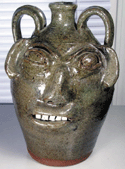
Burlon Craig Face Jug, Catawba Valley; his early work is very hot.
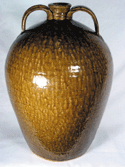
Catawba Valley, NC, 5-gal. jug, unsigned but attributed to Samuel Propst
(1882-1935). A signed example sold for several thousand.
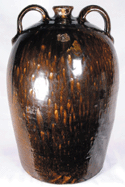
Crawford Co., Ga., pottery showing the Edgefield influence.
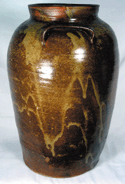
Tall storage jar attributed to Dave, priced at $2,750.
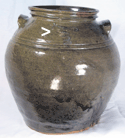 
Dave jar marked with "LM" written vertically near rim (see arrow)|
and
horseshoe, slash, date,
(bottom photo) and punctuates.
Sold for $14,000.
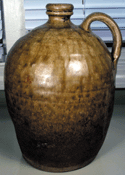
B.F. Landrum jug, Edgefield, ca. 1860. B.F.'s uncle is credited with
introducing alkaline-glazing to the South.
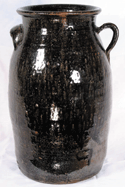
Cheever Meaders 5 gal. churn.
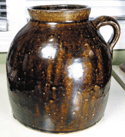
Sand Mtn., Alabama, ca. 1880, high-fired, high quality
alkaline-glazed
pottery sought
by collectors.
|